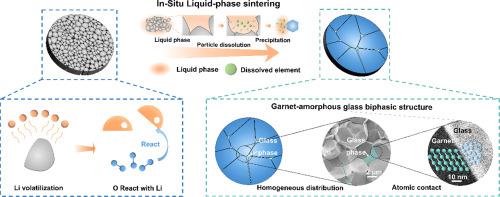枝晶抑制石榴石-非晶玻璃双相电解液原位液相烧结制备高性能固态电池
IF 20.2
1区 材料科学
Q1 CHEMISTRY, PHYSICAL
引用次数: 0
摘要
石榴石型Li6.5La3Zr1.5Ta0.5O12 (LLZTO)是下一代固态电池中很有前途的固体电解质,具有高的抗锂稳定性和优异的离子导电性。然而,近表面微孔中Li+的沉积会严重触发电解质断裂和锂枝晶的扩展。为了克服这一限制,采用原位液相烧结工艺制备了一种具有高离子电导率的新型石榴石-非晶玻璃双相结构的LLZTO电解质。与LLZTO晶粒形成原子级结合的非晶玻璃相源于烧结过程中原位形成的活性液相的凝固,最终在LLZTO晶粒三结处实现均匀分布,有效地消除了整个电解质中的大块微孔和近表面微孔。得益于双相结构,Li|LLZTO|Li对称电池的临界电流密度(CCD)从0.5 mA cm-2显著提高到1.0 mA cm-2。此外,与LiNi0.6Co0.2Mn0.2O2阴极配对的完整电池在100次循环后保持99%的容量保持率。本文创新性地提出了一种消除近表面微孔的新型双相结构电解质形成机制,为抑制锂枝晶生长提供了一种新的策略。本文章由计算机程序翻译,如有差异,请以英文原文为准。

Dendrite-suppressed garnet-amorphous glass biphasic electrolyte via in-situ liquid phase sintering for high-performance solid-state batteries
Garnet-type Li6.5La3Zr1.5Ta0.5O12 (LLZTO) is a promising solid electrolyte for next-generation solid-state batteries, offering high stability against lithium and superior ionic conductivity. However, Li+ deposition at near-surface micropores critically triggers electrolyte fracture and lithium dendrite propagation. To overcome the limitation, a novel garnet-amorphous glass biphasic structure of LLZTO electrolyte with high ionic conductivity was fabricated through an in-situ liquid-phase sintering process. The amorphous glass phase establishing atomic-level bonding with LLZTO grains, originates from the solidification of active liquid phase formed in situ during sintering and eventually achieves homogeneous distribution at LLZTO grain triple junctions which effectively eliminates bulk and near surface micropores throughout the electrolyte. Benefitting from the biphasic structure, the critical current density (CCD) of Li|LLZTO|Li symmetric cells were significantly enhanced from 0.5 mA cm-2 to 1.0 mA cm-2. Furthermore, full cells paired with LiNi0.6Co0.2Mn0.2O2 cathode retain 99 % capacity retention after 100 cycles. This work innovatively presents a novel biphasic structure electrolyte formation mechanism of eliminating near-surface micropores, offering a new strategy for suppressing lithium dendrite growth.
求助全文
通过发布文献求助,成功后即可免费获取论文全文。
去求助
来源期刊

Energy Storage Materials
Materials Science-General Materials Science
CiteScore
33.00
自引率
5.90%
发文量
652
审稿时长
27 days
期刊介绍:
Energy Storage Materials is a global interdisciplinary journal dedicated to sharing scientific and technological advancements in materials and devices for advanced energy storage and related energy conversion, such as in metal-O2 batteries. The journal features comprehensive research articles, including full papers and short communications, as well as authoritative feature articles and reviews by leading experts in the field.
Energy Storage Materials covers a wide range of topics, including the synthesis, fabrication, structure, properties, performance, and technological applications of energy storage materials. Additionally, the journal explores strategies, policies, and developments in the field of energy storage materials and devices for sustainable energy.
Published papers are selected based on their scientific and technological significance, their ability to provide valuable new knowledge, and their relevance to the international research community.
 求助内容:
求助内容: 应助结果提醒方式:
应助结果提醒方式:


